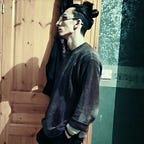If I had to mention one pivotal moment in the evolution of my thinking, it would be the day when I carved on paper that, knowledge is discerning. During that period, I was working extensively on my chessologic theory. What happened was that, a thought led to another until I stated the obvious, yet the feelings I got about it wasn’t that trivial.
I felt that I was onto something important … to me at least. What did you expect? All of this is about me.
For a while, my curiosity oscillated between two questions, what is the essence of knowledge? And, what is the essential knowledge? The first is a question of origin and the second is of fundamentality. The “important” thing I was onto was the answer to my first question. It was important for me to know what was always involved when knowledge was evoked, appealed to or constructed.
My reading of “knowledge is discerning” confused the act of knowing with the action of distinguishing between things. A peculiar knowledge of a given topic is an ecosystem of distinctions that enables the meaningful formulation of thoughts pertaining to the domain in question.
Knowledge grows from investigating the implications of a given distinction when we make it interact with an environment of pre-existing distinctions. It is by considering two objects as distinct that, we start formulating the simplest explanation as to their difference which often requires us to define concepts stemming from further distinctions to be made and so on, until we obtain a coherent body of knowledge.
Something to point out here is that the natural follow-up of discernment is naming. We come up with words and associate them with things to imply that they are different from the rest, that they are distinguished. Under this regime of understanding, it is clear why inquiry in all of its forms is what makes our language grow and why the richness of one’s vocabulary is associated with his knowledgeability. There is clearly a link between knowledge and language that is more than “language is what enables the expression of knowledge”, there is somewhat of a non-trivial interaction among them in which they mutually shape each other.
For one to fully grasp the depth of what is exposed here, one has to think of whatever we are doing here as the lowest-level at which one can speak about knowledge in general. What I mean by “lowest-level” is the same as what is meant by the machine language as being the lowest-level language in coding. That is, a level at which the details of the inner-working are exposed down to the boring detail. It is practically an intellectual overdo to take a body of knowledge and go about charting all the distinctions one has to make in order to forward all what is put in effect for this piece of understanding to be as it is. And this isn’t even the best part of my analogy.
The machine language isn’t that human-friendly as most of you know and to that problem we came up with higher-level languages where our prescription of what we want to perform is in term of wordings that are fairly understandable and close to the way we think. The obvious consequence is that those higher languages aren’t natural to the machines but that isn’t a problem since you can’t have height without a base; the higher-levels are composed from lower-level pieces. The same scheme is found here where at the lowest-level you have distinctions while when evoking knowledge we speak about: axioms, principles, propositions, conjectures, hypothesis, theory, framework, formalism, etc. All of the previous are what you might have guessed by now, our high-level way of speaking about knowledge and if you dig it carefully you will find that they are made of purposeful distinctions.
Of course, this is no invitation for you to work at the level of distinctions yet but to be aware that they constitute the essence of knowledge. That, all we do be it knowledge-related is a complex handling on these. I won’t be treating the arithmetic of these essential objects here. I am just teasing your substance. But I will say this, taking what I am giving you here is accepting something that will put you on par with someone who speaks the high-language and is able to chant a spell in low-language to produce a miracle impossible to achieve for the high-language-only speakers. You are welcome.
I will leave you with a useful image I associate with the act of distinguishing, that is, drawing a curve on a canvas. The blank canvas is associated with the state of ignorance where nothing is distinguished from anything. The moment you draw a line on such empty you forward something over the rest and by doing so again and again, a form will emerge. And so, a state of knowledge is transcribed. By pushing the imagery further, we say that curves are the result of the hand enacting strokes through various gestures. The same way, knowledge is drawn by those abstract gestures effected by he who inquires.
A realization as a calligrapher; it is not the pen which bleeds ink, but rather the paper which bleeds to the strokes of the sharp nib carving wounds on it. The paper feels like skin and you are the one with the scalpel. — Myself, twitter post.
Now, aren’t you convinced that knowledge is — more than anything — art ?
